How to Interpret and Analyze CSAT Survey Data in 2024
Discover how you can effectively analyze your CSAT Survey data to offer a holistic customer experience in 2024.



If you’re new to running CSAT surveys and are unclear on how to analyze your CSAT data, you’ve come to the right blog.
Companies heavily rely on online surveys to measure customer satisfaction and identify areas for improvement. However, merely collecting data isn't enough; it's crucial for organizations to both interpret and analyze the data effectively to ensure sustained customer satisfaction and take meaningful action based on customer insights to drive positive change.
So, how can you ensure that these customer surveys lead to an increase in satisfied customers rather than just being mere data collection exercises?
In this blog, we’ll explore how you can analyze your CSAT survey data in 2024.

What is CSAT?
The Customer Satisfaction Score (CSAT) measures how much your customers are satisfied with your product or service. Through CSAT surveys, you can ask open-ended questions to your customers to analyze their satisfaction with your company’s products or services. These surveys can be distributed either via email campaigns, added within your app interface, or during live chat sessions, and can also be strategically timed at touchpoints(e.g., post-purchase or after a customer service interaction) to gauge satisfaction levels within your customer segments.
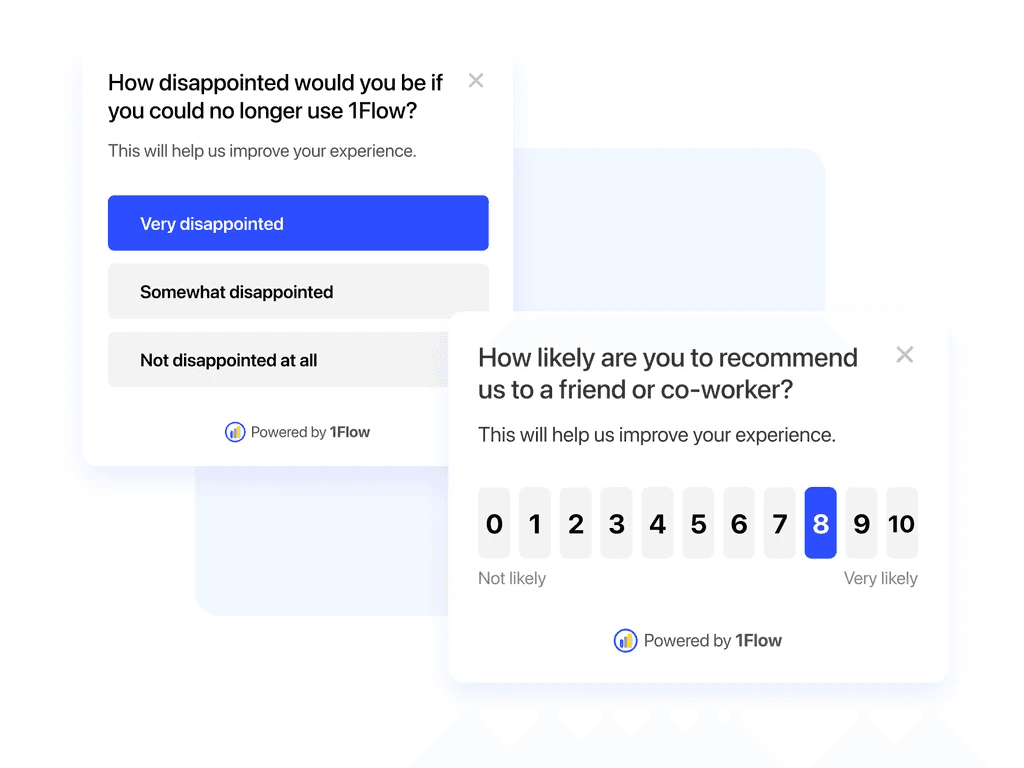
For instance, brands like Airbnb use CSAT to examine customers’ experience with their service.

CSAT surveys can have qualitative questions such as “What could we have done better to make your experience happy?” or quantitative questions like “Please give your customer service representative a rating out of five stars.”
💡With 1Flow you can launch effective in-app surveys to collect actionable customer feedback when customers are browsing your website or interacting with your mobile app to improve overall customer satisfaction.
What's a good CSAT score?
While CSAT score expectations vary across industries, determining what constitutes a good Customer Satisfaction (CSAT) score depends on various factors, including your industry benchmarks, business objectives, and customer expectations.
A CSAT score is typically expressed as a percentage, calculated by dividing the number of positive and negative experiences by the total number of respondents and multiplying by 100. For example, if 80 out of 100 respondents report being satisfied with their experience, the CSAT score would be 80%.
A good score typically falls between 70% and 80%. Since CSAT measures only your Net promoter scores, obtaining a near-perfect score is difficult. Having a score of 75% means that three out of every four customers gave you a positive score instead of a negative or neutral one.
While there is no universally accepted benchmark for a "good" CSAT score, many companies aim for scores above 80% to indicate greater customer satisfaction. In industries like hospitality and travel, achieving a score above 90% may be more realistic due to higher customer service standards, while in others like real estate and banking, average scores within 70-80% may be considered satisfactory.
4 Best Practices To Increase the Response Rate
Sending surveys that don’t get any responses is like fishing in an ocean and only catching one fish. You need to ensure that your customers actively fill out your surveys. Let's explore 4 best you can follow to increase your response rate ⬇️
Keep the surveys short
Lengthy surveys can limit the number of responses you receive on your customer satisfaction surveys. Based on a recent survey conducted by HubSpot, it was found that the optimal survey duration falls within the range of 10 to 14 minutes, with respondents generally willing to engage with 7 to 10 survey questions.

Shorter, more concise questions that ask specific details from your customers are much easier for respondents to fill in since it allows them to understand quickly and accurately what the question is looking at. By minimizing survey length, you also increase the likelihood of completion and obtain higher-quality responses.
Personalize the survey
Instead of randomly sending email surveys and texts to your customers, tailor them to the individual's customer journey. It can be a game changer when it comes to survey response rates since people are most likely to respond if they feel a personal connection with your offerings.
For example, if a customer recently made a purchase, you could personalize the survey by referencing the specific product or service they bought.
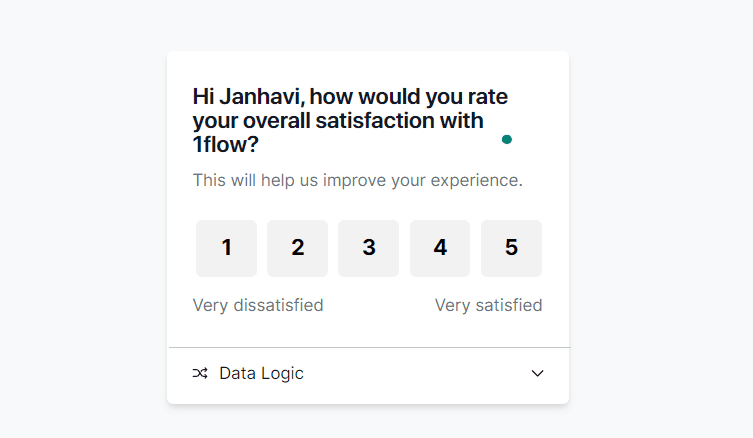
💡1flow can personalize your online surveys and messaging with user traits like name, email, phone, and other customer satisfaction survey data. You can greet the users by their name, show them personalized messaging, and have high-converting messaging at scale minus the extra engineering effort.
Use multiple channels to send surveys
Reach out to customers through various communication channels to maximize survey visibility and accessibility. Consider sending personalized email sequences with a survey link.

You can also send your customer base an SMS inviting them to participate by providing a link to the survey.
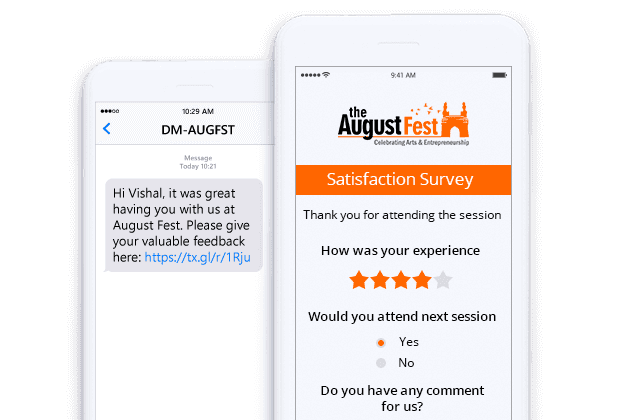
Posting a survey link on your company's social media profiles on Instagram, Twitter, etc encourages your followers to share their feedback. You can also display a pop-up survey prompt when customers visit your website, allowing them to provide real-time feedback.
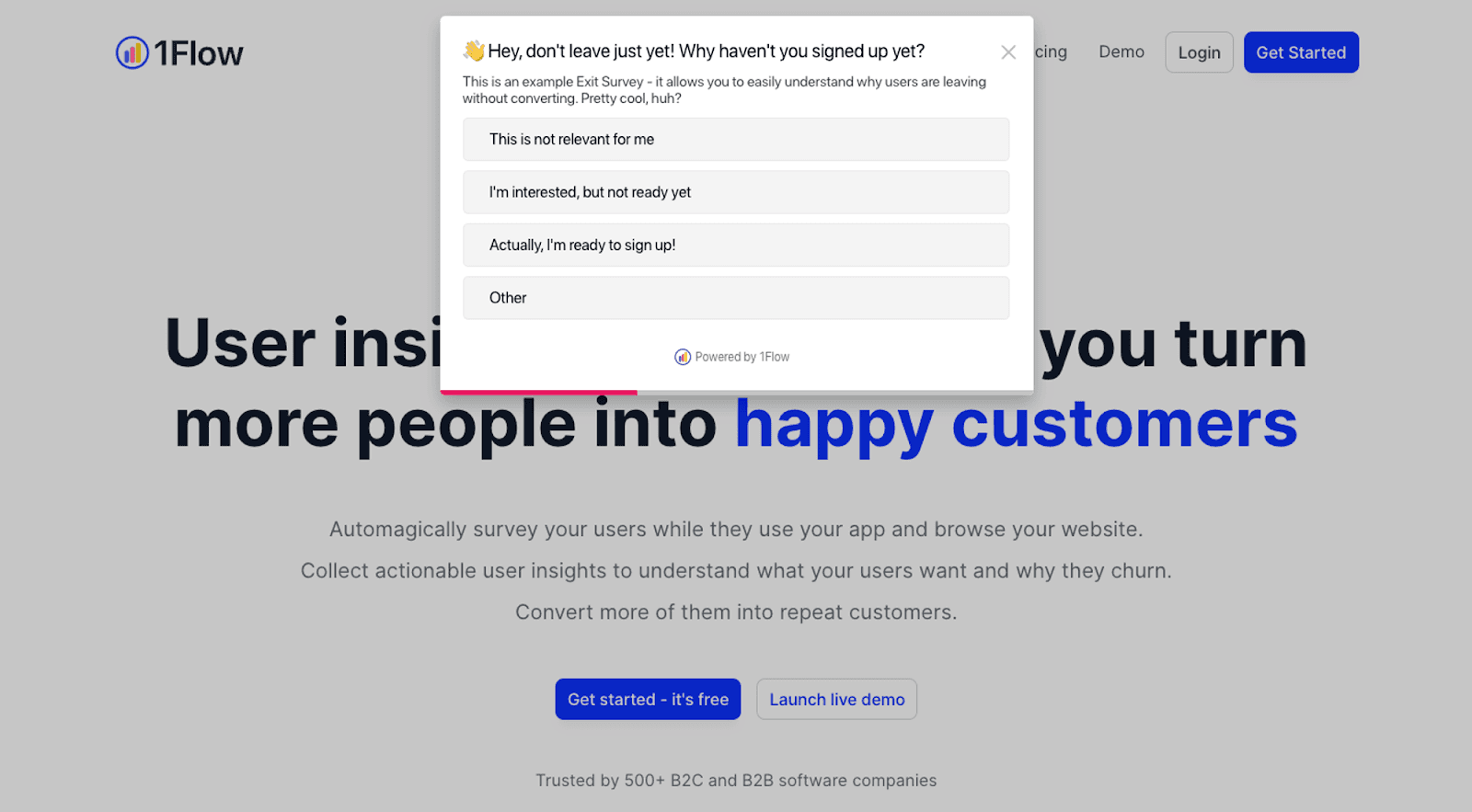
Lastly, If you have a mobile app, send a push notification prompting users to complete a survey directly within the app.
💡Also read In-App Survey Questions: 65+ Examples and Templates to Use
Incentivise users into participating
Most people tend to overlook or disregard customer feedback surveys unless there's a reason for them to participate. Incentives can play a huge role in overcoming this indifference and motivating your customers to take the time to provide feedback.
You can encourage participation by offering rewards such as discounts, coupons, and freebies to customers who complete the survey. Understanding your customers' preferences and interests can help tailor incentives that resonate with them and increase their willingness to engage with the survey.
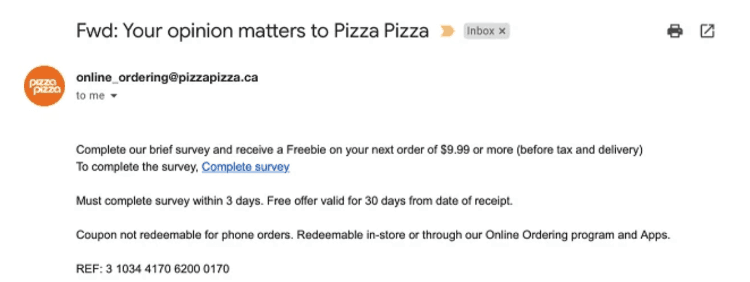
7 Steps to Interpret CSAT survey results
1. Review the Customer Satisfaction Survey Results
Conduct a preliminary analysis of the survey results to gain an overview of the overall customer satisfaction levels. Focus on identifying any immediate trends or outliers that may require your attention.
For example - if there's a sudden increase in negative feedback after a recent product launch, try to find the root cause by analyzing customer feedback. This can give you actionable insights into areas that require your attention or potential opportunities to improve your product.
2. Use Patterns to Form Quick Conclusions
Analyze the survey responses you receive to identify any recurring patterns or themes. Look for common feedback themes across multiple responses, which can provide valuable insights into areas of strength or concern.
For instance, if customers frequently say your app has a poor UI, speak to your design team to make relevant changes.
3. Analyze Results Across Various Customer Segments
Segment survey results based on demographic factors such as age, gender, location, or purchasing behavior. This will be crucial in determining and analyzing satisfaction levels across different customer segments and can reveal specific areas where satisfaction varies and help tailor strategies accordingly.
Let’s say you’re an e-commerce platform that wants to conduct a CSAT survey to evaluate customer satisfaction with their online shopping experience. You can segment survey respondents into three age groups: millennials (ages 18-34), Generation X (ages 35-54), and Boomers (ages 55+).
4. Explain the Importance of Each Metric to Your Team
Ensure that employees understand the significance of each CSAT metric and how it contributes to overall customer satisfaction. Provide training and guidance on interpreting survey results and encourage a customer-centric mindset throughout the organization.
For example, Net Promoter Score and Customer Effort Score are critical customer satisfaction metrics used to measure customer loyalty and satisfaction, but have certain differences. NPS measures CX as a whole, whereas CES measures how much effort a customer puts in when answering your survey.
💡Also read: Why Use NPS: Benefits of Running NPS Surveys
5. Determine the Next Steps of Action
Based on the insights gained from survey analysis, identify actionable steps to address areas of improvement and capitalize on strengths. Prioritize initiatives that have the potential to have the greatest impact on enhancing customer satisfaction.
Let's say an eCommerce beauty store has conducted a CSAT survey and identified two things: Customers consistently praise the skin care products but face payment issues and leave items in the cart.
To address this, you can plan to include additional payment options during checkout peak and can also find new ways to introduce new combos and offerings to increase sales.
6. Try to solve the critical problems
Focus on resolving the key customer issues you have identified through the survey results and implement targeted solutions and initiatives to address customer concerns. For instance, if customers consistently report dissatisfaction with shipping delays, implementing a tracking system to provide real-time updates and optimizing logistics to expedite delivery can be pivotal solutions.
7. Ask for customer feedback Again
After you’ve made the changes and implemented strategies, it's time to resend the survey questions to customers when it's suitable. Remember to ask your customers for feedback again by conducting satisfaction surveys after a product update or using comment sections on blog posts to gather feedback on new features.
Simultaneously, tracking the effectiveness of these initiatives through customer feedback loops, such as monitoring online reviews or analyzing survey responses can guarantee an increase in loyal customers.
Equally essential is the continuous availability of feedback channels after implementation, such as a customer service chat box or feedback forms on the company website or as in-app notifications, this helps with ongoing assessment of satisfaction levels and detects any underlying concerns.
5 ways to use CSAT Results
Now that we understand the importance of Customer Satisfaction (CSAT) surveys and how to interpret their results, let's explore five effective strategies for leveraging those insights.
Identify Ways to Reduce Customer Churn
Upon analyzing CSAT results, identify and address any pressing issues that demand immediate attention to prevent further customer dissatisfaction. For example, if unsatisfied customers report receiving damaged products from your e-commerce platform, prioritize implementing stricter quality control measures and expedited shipping options to rectify the issue promptly.
Establish clear guidelines for interpreting these metrics. Refer to the table to determine warning levels associated with different CSAT score ranges, which will help you make informed decisions about your next step and design targeted interventions to address customer satisfaction issues.

Analyze the Root Cause
After you have identified the core problem, it's time to dive deeper into the root causes of these recurring issues highlighted in your CSAT survey responses. The purpose here should be to understand their origin. For instance, if customers consistently complain about long wait times for customer support, investigate whether it's due to understaffing, inefficient processes, or technical difficulties, and take targeted actions to streamline operations and improve service efficiency.
Let’s look at how to identify the problem's origin-
Define the problem: Let’s say that the issue identified is that your customers complain about long support wait times.
Identify possible causes: Is it due to understaffing, inefficient processes, or technical issues?
Investigate the issue: Thoroughly examine each potential cause by gathering information on staffing levels, process efficiency, and technical systems.
Analyze your data: Review this data to determine if any cause is the primary contributor.
Confirm Root Cause: Verify the primary cause of the issue based on your data analysis.
Take Action: Address the confirmed root cause to improve the situation.
Monitor your progress: Track changes and customer feedback to ensure the issue is resolved effectively.
3. Find New Ideas
Your customer base is your best source of ideas. If you want to know ways of improving your products, send out surveys asking for their suggestions. For instance, if customers repeatedly request a specific product feature, you can get your tech team to work and optimize your platform to improve user acquisition.
4. Set Targets to achieve CX goals
Utilize these CSAT results to establish specific and measurable targets for improving the overall customer experience for your customers For example, if the current CSAT score is 65%, set a goal to increase it to 75% within the next six months by implementing specific initiatives aimed at addressing the pain points that you have identified. Some targets include:
Reducing response time for customer support
Improving product availability
Designing a hassle-free checkout process
Implementing product updates and enhancements
5. Allocate Resources Strategically
Resource and budget allocation is key for any business to succeed. When you know your CX goals, you can prioritize your workload accordingly. For instance, if enhancing website usability emerges as a priority based on customer feedback, invest in user experience (UX) design improvements, website optimization tools, and training for web development teams to deliver a more intuitive experience.
Measure CSAT Effectively with 1flow
If you’re looking for customer feedback tools to improve your customer satisfaction, look no further than 1flow.
1flow offers powerful user segmentation and targeting that allows you to ask your users the right questions based on their interaction with your app.
Our analytics dashboard gives you a clear picture of how customers respond so you can take the right measures and provide positive experiences to your customers.
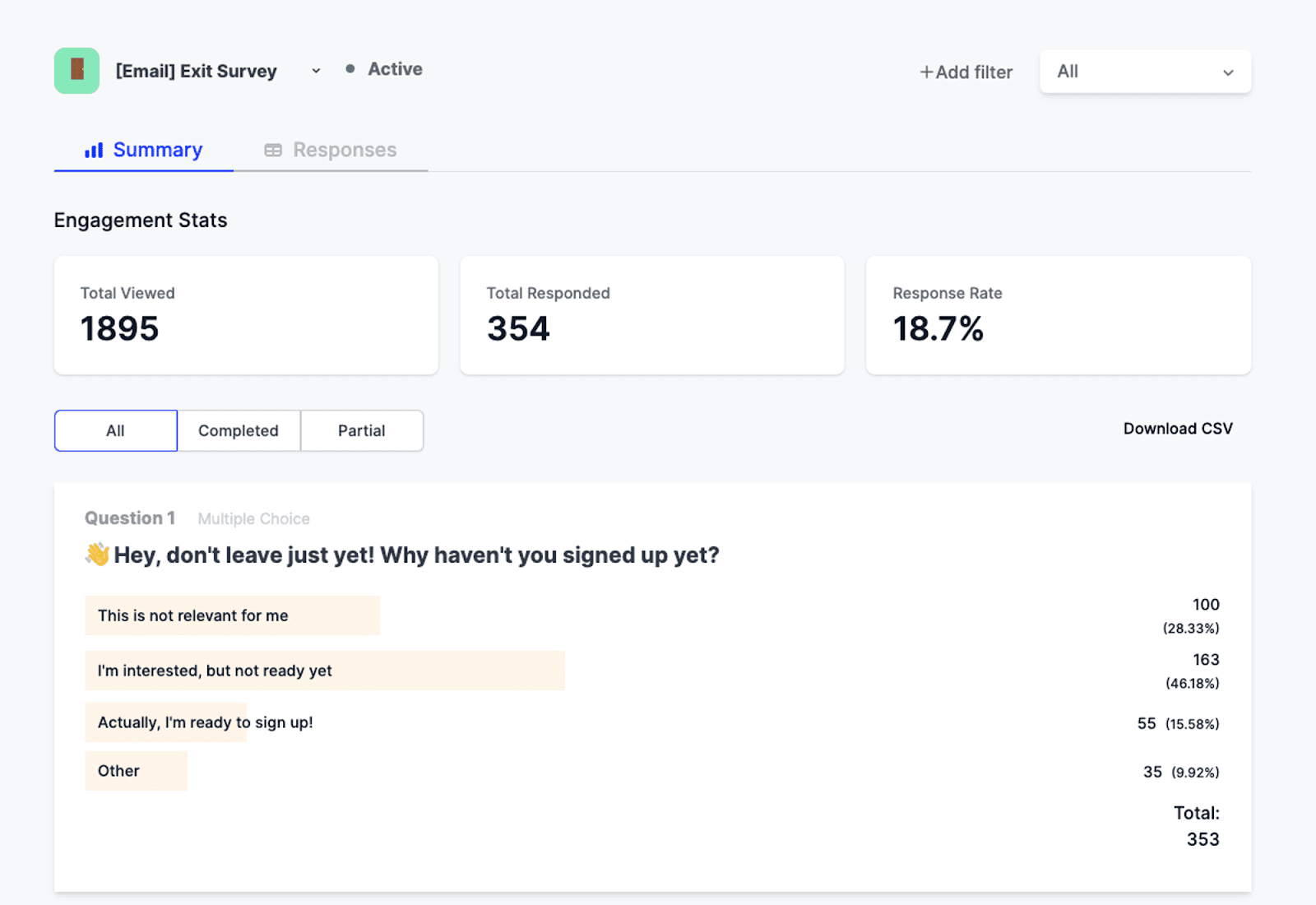
Plus, with 1flow AI, you can create personalized surveys on the fly and gather feedback from various sources, including websites, in-app, or social media.

Ready to offer better product experiences? Sign up for 1flow today!
If you’re new to running CSAT surveys and are unclear on how to analyze your CSAT data, you’ve come to the right blog.
Companies heavily rely on online surveys to measure customer satisfaction and identify areas for improvement. However, merely collecting data isn't enough; it's crucial for organizations to both interpret and analyze the data effectively to ensure sustained customer satisfaction and take meaningful action based on customer insights to drive positive change.
So, how can you ensure that these customer surveys lead to an increase in satisfied customers rather than just being mere data collection exercises?
In this blog, we’ll explore how you can analyze your CSAT survey data in 2024.

What is CSAT?
The Customer Satisfaction Score (CSAT) measures how much your customers are satisfied with your product or service. Through CSAT surveys, you can ask open-ended questions to your customers to analyze their satisfaction with your company’s products or services. These surveys can be distributed either via email campaigns, added within your app interface, or during live chat sessions, and can also be strategically timed at touchpoints(e.g., post-purchase or after a customer service interaction) to gauge satisfaction levels within your customer segments.

For instance, brands like Airbnb use CSAT to examine customers’ experience with their service.

CSAT surveys can have qualitative questions such as “What could we have done better to make your experience happy?” or quantitative questions like “Please give your customer service representative a rating out of five stars.”
💡With 1Flow you can launch effective in-app surveys to collect actionable customer feedback when customers are browsing your website or interacting with your mobile app to improve overall customer satisfaction.
What's a good CSAT score?
While CSAT score expectations vary across industries, determining what constitutes a good Customer Satisfaction (CSAT) score depends on various factors, including your industry benchmarks, business objectives, and customer expectations.
A CSAT score is typically expressed as a percentage, calculated by dividing the number of positive and negative experiences by the total number of respondents and multiplying by 100. For example, if 80 out of 100 respondents report being satisfied with their experience, the CSAT score would be 80%.
A good score typically falls between 70% and 80%. Since CSAT measures only your Net promoter scores, obtaining a near-perfect score is difficult. Having a score of 75% means that three out of every four customers gave you a positive score instead of a negative or neutral one.
While there is no universally accepted benchmark for a "good" CSAT score, many companies aim for scores above 80% to indicate greater customer satisfaction. In industries like hospitality and travel, achieving a score above 90% may be more realistic due to higher customer service standards, while in others like real estate and banking, average scores within 70-80% may be considered satisfactory.
4 Best Practices To Increase the Response Rate
Sending surveys that don’t get any responses is like fishing in an ocean and only catching one fish. You need to ensure that your customers actively fill out your surveys. Let's explore 4 best you can follow to increase your response rate ⬇️
Keep the surveys short
Lengthy surveys can limit the number of responses you receive on your customer satisfaction surveys. Based on a recent survey conducted by HubSpot, it was found that the optimal survey duration falls within the range of 10 to 14 minutes, with respondents generally willing to engage with 7 to 10 survey questions.

Shorter, more concise questions that ask specific details from your customers are much easier for respondents to fill in since it allows them to understand quickly and accurately what the question is looking at. By minimizing survey length, you also increase the likelihood of completion and obtain higher-quality responses.
Personalize the survey
Instead of randomly sending email surveys and texts to your customers, tailor them to the individual's customer journey. It can be a game changer when it comes to survey response rates since people are most likely to respond if they feel a personal connection with your offerings.
For example, if a customer recently made a purchase, you could personalize the survey by referencing the specific product or service they bought.

💡1flow can personalize your online surveys and messaging with user traits like name, email, phone, and other customer satisfaction survey data. You can greet the users by their name, show them personalized messaging, and have high-converting messaging at scale minus the extra engineering effort.
Use multiple channels to send surveys
Reach out to customers through various communication channels to maximize survey visibility and accessibility. Consider sending personalized email sequences with a survey link.

You can also send your customer base an SMS inviting them to participate by providing a link to the survey.

Posting a survey link on your company's social media profiles on Instagram, Twitter, etc encourages your followers to share their feedback. You can also display a pop-up survey prompt when customers visit your website, allowing them to provide real-time feedback.

Lastly, If you have a mobile app, send a push notification prompting users to complete a survey directly within the app.
💡Also read In-App Survey Questions: 65+ Examples and Templates to Use
Incentivise users into participating
Most people tend to overlook or disregard customer feedback surveys unless there's a reason for them to participate. Incentives can play a huge role in overcoming this indifference and motivating your customers to take the time to provide feedback.
You can encourage participation by offering rewards such as discounts, coupons, and freebies to customers who complete the survey. Understanding your customers' preferences and interests can help tailor incentives that resonate with them and increase their willingness to engage with the survey.

7 Steps to Interpret CSAT survey results
1. Review the Customer Satisfaction Survey Results
Conduct a preliminary analysis of the survey results to gain an overview of the overall customer satisfaction levels. Focus on identifying any immediate trends or outliers that may require your attention.
For example - if there's a sudden increase in negative feedback after a recent product launch, try to find the root cause by analyzing customer feedback. This can give you actionable insights into areas that require your attention or potential opportunities to improve your product.
2. Use Patterns to Form Quick Conclusions
Analyze the survey responses you receive to identify any recurring patterns or themes. Look for common feedback themes across multiple responses, which can provide valuable insights into areas of strength or concern.
For instance, if customers frequently say your app has a poor UI, speak to your design team to make relevant changes.
3. Analyze Results Across Various Customer Segments
Segment survey results based on demographic factors such as age, gender, location, or purchasing behavior. This will be crucial in determining and analyzing satisfaction levels across different customer segments and can reveal specific areas where satisfaction varies and help tailor strategies accordingly.
Let’s say you’re an e-commerce platform that wants to conduct a CSAT survey to evaluate customer satisfaction with their online shopping experience. You can segment survey respondents into three age groups: millennials (ages 18-34), Generation X (ages 35-54), and Boomers (ages 55+).
4. Explain the Importance of Each Metric to Your Team
Ensure that employees understand the significance of each CSAT metric and how it contributes to overall customer satisfaction. Provide training and guidance on interpreting survey results and encourage a customer-centric mindset throughout the organization.
For example, Net Promoter Score and Customer Effort Score are critical customer satisfaction metrics used to measure customer loyalty and satisfaction, but have certain differences. NPS measures CX as a whole, whereas CES measures how much effort a customer puts in when answering your survey.
💡Also read: Why Use NPS: Benefits of Running NPS Surveys
5. Determine the Next Steps of Action
Based on the insights gained from survey analysis, identify actionable steps to address areas of improvement and capitalize on strengths. Prioritize initiatives that have the potential to have the greatest impact on enhancing customer satisfaction.
Let's say an eCommerce beauty store has conducted a CSAT survey and identified two things: Customers consistently praise the skin care products but face payment issues and leave items in the cart.
To address this, you can plan to include additional payment options during checkout peak and can also find new ways to introduce new combos and offerings to increase sales.
6. Try to solve the critical problems
Focus on resolving the key customer issues you have identified through the survey results and implement targeted solutions and initiatives to address customer concerns. For instance, if customers consistently report dissatisfaction with shipping delays, implementing a tracking system to provide real-time updates and optimizing logistics to expedite delivery can be pivotal solutions.
7. Ask for customer feedback Again
After you’ve made the changes and implemented strategies, it's time to resend the survey questions to customers when it's suitable. Remember to ask your customers for feedback again by conducting satisfaction surveys after a product update or using comment sections on blog posts to gather feedback on new features.
Simultaneously, tracking the effectiveness of these initiatives through customer feedback loops, such as monitoring online reviews or analyzing survey responses can guarantee an increase in loyal customers.
Equally essential is the continuous availability of feedback channels after implementation, such as a customer service chat box or feedback forms on the company website or as in-app notifications, this helps with ongoing assessment of satisfaction levels and detects any underlying concerns.
5 ways to use CSAT Results
Now that we understand the importance of Customer Satisfaction (CSAT) surveys and how to interpret their results, let's explore five effective strategies for leveraging those insights.
Identify Ways to Reduce Customer Churn
Upon analyzing CSAT results, identify and address any pressing issues that demand immediate attention to prevent further customer dissatisfaction. For example, if unsatisfied customers report receiving damaged products from your e-commerce platform, prioritize implementing stricter quality control measures and expedited shipping options to rectify the issue promptly.
Establish clear guidelines for interpreting these metrics. Refer to the table to determine warning levels associated with different CSAT score ranges, which will help you make informed decisions about your next step and design targeted interventions to address customer satisfaction issues.

Analyze the Root Cause
After you have identified the core problem, it's time to dive deeper into the root causes of these recurring issues highlighted in your CSAT survey responses. The purpose here should be to understand their origin. For instance, if customers consistently complain about long wait times for customer support, investigate whether it's due to understaffing, inefficient processes, or technical difficulties, and take targeted actions to streamline operations and improve service efficiency.
Let’s look at how to identify the problem's origin-
Define the problem: Let’s say that the issue identified is that your customers complain about long support wait times.
Identify possible causes: Is it due to understaffing, inefficient processes, or technical issues?
Investigate the issue: Thoroughly examine each potential cause by gathering information on staffing levels, process efficiency, and technical systems.
Analyze your data: Review this data to determine if any cause is the primary contributor.
Confirm Root Cause: Verify the primary cause of the issue based on your data analysis.
Take Action: Address the confirmed root cause to improve the situation.
Monitor your progress: Track changes and customer feedback to ensure the issue is resolved effectively.
3. Find New Ideas
Your customer base is your best source of ideas. If you want to know ways of improving your products, send out surveys asking for their suggestions. For instance, if customers repeatedly request a specific product feature, you can get your tech team to work and optimize your platform to improve user acquisition.
4. Set Targets to achieve CX goals
Utilize these CSAT results to establish specific and measurable targets for improving the overall customer experience for your customers For example, if the current CSAT score is 65%, set a goal to increase it to 75% within the next six months by implementing specific initiatives aimed at addressing the pain points that you have identified. Some targets include:
Reducing response time for customer support
Improving product availability
Designing a hassle-free checkout process
Implementing product updates and enhancements
5. Allocate Resources Strategically
Resource and budget allocation is key for any business to succeed. When you know your CX goals, you can prioritize your workload accordingly. For instance, if enhancing website usability emerges as a priority based on customer feedback, invest in user experience (UX) design improvements, website optimization tools, and training for web development teams to deliver a more intuitive experience.
Measure CSAT Effectively with 1flow
If you’re looking for customer feedback tools to improve your customer satisfaction, look no further than 1flow.
1flow offers powerful user segmentation and targeting that allows you to ask your users the right questions based on their interaction with your app.
Our analytics dashboard gives you a clear picture of how customers respond so you can take the right measures and provide positive experiences to your customers.

Plus, with 1flow AI, you can create personalized surveys on the fly and gather feedback from various sources, including websites, in-app, or social media.

Ready to offer better product experiences? Sign up for 1flow today!
If you’re new to running CSAT surveys and are unclear on how to analyze your CSAT data, you’ve come to the right blog.
Companies heavily rely on online surveys to measure customer satisfaction and identify areas for improvement. However, merely collecting data isn't enough; it's crucial for organizations to both interpret and analyze the data effectively to ensure sustained customer satisfaction and take meaningful action based on customer insights to drive positive change.
So, how can you ensure that these customer surveys lead to an increase in satisfied customers rather than just being mere data collection exercises?
In this blog, we’ll explore how you can analyze your CSAT survey data in 2024.

What is CSAT?
The Customer Satisfaction Score (CSAT) measures how much your customers are satisfied with your product or service. Through CSAT surveys, you can ask open-ended questions to your customers to analyze their satisfaction with your company’s products or services. These surveys can be distributed either via email campaigns, added within your app interface, or during live chat sessions, and can also be strategically timed at touchpoints(e.g., post-purchase or after a customer service interaction) to gauge satisfaction levels within your customer segments.

For instance, brands like Airbnb use CSAT to examine customers’ experience with their service.

CSAT surveys can have qualitative questions such as “What could we have done better to make your experience happy?” or quantitative questions like “Please give your customer service representative a rating out of five stars.”
💡With 1Flow you can launch effective in-app surveys to collect actionable customer feedback when customers are browsing your website or interacting with your mobile app to improve overall customer satisfaction.
What's a good CSAT score?
While CSAT score expectations vary across industries, determining what constitutes a good Customer Satisfaction (CSAT) score depends on various factors, including your industry benchmarks, business objectives, and customer expectations.
A CSAT score is typically expressed as a percentage, calculated by dividing the number of positive and negative experiences by the total number of respondents and multiplying by 100. For example, if 80 out of 100 respondents report being satisfied with their experience, the CSAT score would be 80%.
A good score typically falls between 70% and 80%. Since CSAT measures only your Net promoter scores, obtaining a near-perfect score is difficult. Having a score of 75% means that three out of every four customers gave you a positive score instead of a negative or neutral one.
While there is no universally accepted benchmark for a "good" CSAT score, many companies aim for scores above 80% to indicate greater customer satisfaction. In industries like hospitality and travel, achieving a score above 90% may be more realistic due to higher customer service standards, while in others like real estate and banking, average scores within 70-80% may be considered satisfactory.
4 Best Practices To Increase the Response Rate
Sending surveys that don’t get any responses is like fishing in an ocean and only catching one fish. You need to ensure that your customers actively fill out your surveys. Let's explore 4 best you can follow to increase your response rate ⬇️
Keep the surveys short
Lengthy surveys can limit the number of responses you receive on your customer satisfaction surveys. Based on a recent survey conducted by HubSpot, it was found that the optimal survey duration falls within the range of 10 to 14 minutes, with respondents generally willing to engage with 7 to 10 survey questions.

Shorter, more concise questions that ask specific details from your customers are much easier for respondents to fill in since it allows them to understand quickly and accurately what the question is looking at. By minimizing survey length, you also increase the likelihood of completion and obtain higher-quality responses.
Personalize the survey
Instead of randomly sending email surveys and texts to your customers, tailor them to the individual's customer journey. It can be a game changer when it comes to survey response rates since people are most likely to respond if they feel a personal connection with your offerings.
For example, if a customer recently made a purchase, you could personalize the survey by referencing the specific product or service they bought.

💡1flow can personalize your online surveys and messaging with user traits like name, email, phone, and other customer satisfaction survey data. You can greet the users by their name, show them personalized messaging, and have high-converting messaging at scale minus the extra engineering effort.
Use multiple channels to send surveys
Reach out to customers through various communication channels to maximize survey visibility and accessibility. Consider sending personalized email sequences with a survey link.

You can also send your customer base an SMS inviting them to participate by providing a link to the survey.

Posting a survey link on your company's social media profiles on Instagram, Twitter, etc encourages your followers to share their feedback. You can also display a pop-up survey prompt when customers visit your website, allowing them to provide real-time feedback.

Lastly, If you have a mobile app, send a push notification prompting users to complete a survey directly within the app.
💡Also read In-App Survey Questions: 65+ Examples and Templates to Use
Incentivise users into participating
Most people tend to overlook or disregard customer feedback surveys unless there's a reason for them to participate. Incentives can play a huge role in overcoming this indifference and motivating your customers to take the time to provide feedback.
You can encourage participation by offering rewards such as discounts, coupons, and freebies to customers who complete the survey. Understanding your customers' preferences and interests can help tailor incentives that resonate with them and increase their willingness to engage with the survey.

7 Steps to Interpret CSAT survey results
1. Review the Customer Satisfaction Survey Results
Conduct a preliminary analysis of the survey results to gain an overview of the overall customer satisfaction levels. Focus on identifying any immediate trends or outliers that may require your attention.
For example - if there's a sudden increase in negative feedback after a recent product launch, try to find the root cause by analyzing customer feedback. This can give you actionable insights into areas that require your attention or potential opportunities to improve your product.
2. Use Patterns to Form Quick Conclusions
Analyze the survey responses you receive to identify any recurring patterns or themes. Look for common feedback themes across multiple responses, which can provide valuable insights into areas of strength or concern.
For instance, if customers frequently say your app has a poor UI, speak to your design team to make relevant changes.
3. Analyze Results Across Various Customer Segments
Segment survey results based on demographic factors such as age, gender, location, or purchasing behavior. This will be crucial in determining and analyzing satisfaction levels across different customer segments and can reveal specific areas where satisfaction varies and help tailor strategies accordingly.
Let’s say you’re an e-commerce platform that wants to conduct a CSAT survey to evaluate customer satisfaction with their online shopping experience. You can segment survey respondents into three age groups: millennials (ages 18-34), Generation X (ages 35-54), and Boomers (ages 55+).
4. Explain the Importance of Each Metric to Your Team
Ensure that employees understand the significance of each CSAT metric and how it contributes to overall customer satisfaction. Provide training and guidance on interpreting survey results and encourage a customer-centric mindset throughout the organization.
For example, Net Promoter Score and Customer Effort Score are critical customer satisfaction metrics used to measure customer loyalty and satisfaction, but have certain differences. NPS measures CX as a whole, whereas CES measures how much effort a customer puts in when answering your survey.
💡Also read: Why Use NPS: Benefits of Running NPS Surveys
5. Determine the Next Steps of Action
Based on the insights gained from survey analysis, identify actionable steps to address areas of improvement and capitalize on strengths. Prioritize initiatives that have the potential to have the greatest impact on enhancing customer satisfaction.
Let's say an eCommerce beauty store has conducted a CSAT survey and identified two things: Customers consistently praise the skin care products but face payment issues and leave items in the cart.
To address this, you can plan to include additional payment options during checkout peak and can also find new ways to introduce new combos and offerings to increase sales.
6. Try to solve the critical problems
Focus on resolving the key customer issues you have identified through the survey results and implement targeted solutions and initiatives to address customer concerns. For instance, if customers consistently report dissatisfaction with shipping delays, implementing a tracking system to provide real-time updates and optimizing logistics to expedite delivery can be pivotal solutions.
7. Ask for customer feedback Again
After you’ve made the changes and implemented strategies, it's time to resend the survey questions to customers when it's suitable. Remember to ask your customers for feedback again by conducting satisfaction surveys after a product update or using comment sections on blog posts to gather feedback on new features.
Simultaneously, tracking the effectiveness of these initiatives through customer feedback loops, such as monitoring online reviews or analyzing survey responses can guarantee an increase in loyal customers.
Equally essential is the continuous availability of feedback channels after implementation, such as a customer service chat box or feedback forms on the company website or as in-app notifications, this helps with ongoing assessment of satisfaction levels and detects any underlying concerns.
5 ways to use CSAT Results
Now that we understand the importance of Customer Satisfaction (CSAT) surveys and how to interpret their results, let's explore five effective strategies for leveraging those insights.
Identify Ways to Reduce Customer Churn
Upon analyzing CSAT results, identify and address any pressing issues that demand immediate attention to prevent further customer dissatisfaction. For example, if unsatisfied customers report receiving damaged products from your e-commerce platform, prioritize implementing stricter quality control measures and expedited shipping options to rectify the issue promptly.
Establish clear guidelines for interpreting these metrics. Refer to the table to determine warning levels associated with different CSAT score ranges, which will help you make informed decisions about your next step and design targeted interventions to address customer satisfaction issues.

Analyze the Root Cause
After you have identified the core problem, it's time to dive deeper into the root causes of these recurring issues highlighted in your CSAT survey responses. The purpose here should be to understand their origin. For instance, if customers consistently complain about long wait times for customer support, investigate whether it's due to understaffing, inefficient processes, or technical difficulties, and take targeted actions to streamline operations and improve service efficiency.
Let’s look at how to identify the problem's origin-
Define the problem: Let’s say that the issue identified is that your customers complain about long support wait times.
Identify possible causes: Is it due to understaffing, inefficient processes, or technical issues?
Investigate the issue: Thoroughly examine each potential cause by gathering information on staffing levels, process efficiency, and technical systems.
Analyze your data: Review this data to determine if any cause is the primary contributor.
Confirm Root Cause: Verify the primary cause of the issue based on your data analysis.
Take Action: Address the confirmed root cause to improve the situation.
Monitor your progress: Track changes and customer feedback to ensure the issue is resolved effectively.
3. Find New Ideas
Your customer base is your best source of ideas. If you want to know ways of improving your products, send out surveys asking for their suggestions. For instance, if customers repeatedly request a specific product feature, you can get your tech team to work and optimize your platform to improve user acquisition.
4. Set Targets to achieve CX goals
Utilize these CSAT results to establish specific and measurable targets for improving the overall customer experience for your customers For example, if the current CSAT score is 65%, set a goal to increase it to 75% within the next six months by implementing specific initiatives aimed at addressing the pain points that you have identified. Some targets include:
Reducing response time for customer support
Improving product availability
Designing a hassle-free checkout process
Implementing product updates and enhancements
5. Allocate Resources Strategically
Resource and budget allocation is key for any business to succeed. When you know your CX goals, you can prioritize your workload accordingly. For instance, if enhancing website usability emerges as a priority based on customer feedback, invest in user experience (UX) design improvements, website optimization tools, and training for web development teams to deliver a more intuitive experience.
Measure CSAT Effectively with 1flow
If you’re looking for customer feedback tools to improve your customer satisfaction, look no further than 1flow.
1flow offers powerful user segmentation and targeting that allows you to ask your users the right questions based on their interaction with your app.
Our analytics dashboard gives you a clear picture of how customers respond so you can take the right measures and provide positive experiences to your customers.

Plus, with 1flow AI, you can create personalized surveys on the fly and gather feedback from various sources, including websites, in-app, or social media.

Ready to offer better product experiences? Sign up for 1flow today!
If you’re new to running CSAT surveys and are unclear on how to analyze your CSAT data, you’ve come to the right blog.
Companies heavily rely on online surveys to measure customer satisfaction and identify areas for improvement. However, merely collecting data isn't enough; it's crucial for organizations to both interpret and analyze the data effectively to ensure sustained customer satisfaction and take meaningful action based on customer insights to drive positive change.
So, how can you ensure that these customer surveys lead to an increase in satisfied customers rather than just being mere data collection exercises?
In this blog, we’ll explore how you can analyze your CSAT survey data in 2024.

What is CSAT?
The Customer Satisfaction Score (CSAT) measures how much your customers are satisfied with your product or service. Through CSAT surveys, you can ask open-ended questions to your customers to analyze their satisfaction with your company’s products or services. These surveys can be distributed either via email campaigns, added within your app interface, or during live chat sessions, and can also be strategically timed at touchpoints(e.g., post-purchase or after a customer service interaction) to gauge satisfaction levels within your customer segments.

For instance, brands like Airbnb use CSAT to examine customers’ experience with their service.

CSAT surveys can have qualitative questions such as “What could we have done better to make your experience happy?” or quantitative questions like “Please give your customer service representative a rating out of five stars.”
💡With 1Flow you can launch effective in-app surveys to collect actionable customer feedback when customers are browsing your website or interacting with your mobile app to improve overall customer satisfaction.
What's a good CSAT score?
While CSAT score expectations vary across industries, determining what constitutes a good Customer Satisfaction (CSAT) score depends on various factors, including your industry benchmarks, business objectives, and customer expectations.
A CSAT score is typically expressed as a percentage, calculated by dividing the number of positive and negative experiences by the total number of respondents and multiplying by 100. For example, if 80 out of 100 respondents report being satisfied with their experience, the CSAT score would be 80%.
A good score typically falls between 70% and 80%. Since CSAT measures only your Net promoter scores, obtaining a near-perfect score is difficult. Having a score of 75% means that three out of every four customers gave you a positive score instead of a negative or neutral one.
While there is no universally accepted benchmark for a "good" CSAT score, many companies aim for scores above 80% to indicate greater customer satisfaction. In industries like hospitality and travel, achieving a score above 90% may be more realistic due to higher customer service standards, while in others like real estate and banking, average scores within 70-80% may be considered satisfactory.
4 Best Practices To Increase the Response Rate
Sending surveys that don’t get any responses is like fishing in an ocean and only catching one fish. You need to ensure that your customers actively fill out your surveys. Let's explore 4 best you can follow to increase your response rate ⬇️
Keep the surveys short
Lengthy surveys can limit the number of responses you receive on your customer satisfaction surveys. Based on a recent survey conducted by HubSpot, it was found that the optimal survey duration falls within the range of 10 to 14 minutes, with respondents generally willing to engage with 7 to 10 survey questions.

Shorter, more concise questions that ask specific details from your customers are much easier for respondents to fill in since it allows them to understand quickly and accurately what the question is looking at. By minimizing survey length, you also increase the likelihood of completion and obtain higher-quality responses.
Personalize the survey
Instead of randomly sending email surveys and texts to your customers, tailor them to the individual's customer journey. It can be a game changer when it comes to survey response rates since people are most likely to respond if they feel a personal connection with your offerings.
For example, if a customer recently made a purchase, you could personalize the survey by referencing the specific product or service they bought.

💡1flow can personalize your online surveys and messaging with user traits like name, email, phone, and other customer satisfaction survey data. You can greet the users by their name, show them personalized messaging, and have high-converting messaging at scale minus the extra engineering effort.
Use multiple channels to send surveys
Reach out to customers through various communication channels to maximize survey visibility and accessibility. Consider sending personalized email sequences with a survey link.

You can also send your customer base an SMS inviting them to participate by providing a link to the survey.

Posting a survey link on your company's social media profiles on Instagram, Twitter, etc encourages your followers to share their feedback. You can also display a pop-up survey prompt when customers visit your website, allowing them to provide real-time feedback.

Lastly, If you have a mobile app, send a push notification prompting users to complete a survey directly within the app.
💡Also read In-App Survey Questions: 65+ Examples and Templates to Use
Incentivise users into participating
Most people tend to overlook or disregard customer feedback surveys unless there's a reason for them to participate. Incentives can play a huge role in overcoming this indifference and motivating your customers to take the time to provide feedback.
You can encourage participation by offering rewards such as discounts, coupons, and freebies to customers who complete the survey. Understanding your customers' preferences and interests can help tailor incentives that resonate with them and increase their willingness to engage with the survey.

7 Steps to Interpret CSAT survey results
1. Review the Customer Satisfaction Survey Results
Conduct a preliminary analysis of the survey results to gain an overview of the overall customer satisfaction levels. Focus on identifying any immediate trends or outliers that may require your attention.
For example - if there's a sudden increase in negative feedback after a recent product launch, try to find the root cause by analyzing customer feedback. This can give you actionable insights into areas that require your attention or potential opportunities to improve your product.
2. Use Patterns to Form Quick Conclusions
Analyze the survey responses you receive to identify any recurring patterns or themes. Look for common feedback themes across multiple responses, which can provide valuable insights into areas of strength or concern.
For instance, if customers frequently say your app has a poor UI, speak to your design team to make relevant changes.
3. Analyze Results Across Various Customer Segments
Segment survey results based on demographic factors such as age, gender, location, or purchasing behavior. This will be crucial in determining and analyzing satisfaction levels across different customer segments and can reveal specific areas where satisfaction varies and help tailor strategies accordingly.
Let’s say you’re an e-commerce platform that wants to conduct a CSAT survey to evaluate customer satisfaction with their online shopping experience. You can segment survey respondents into three age groups: millennials (ages 18-34), Generation X (ages 35-54), and Boomers (ages 55+).
4. Explain the Importance of Each Metric to Your Team
Ensure that employees understand the significance of each CSAT metric and how it contributes to overall customer satisfaction. Provide training and guidance on interpreting survey results and encourage a customer-centric mindset throughout the organization.
For example, Net Promoter Score and Customer Effort Score are critical customer satisfaction metrics used to measure customer loyalty and satisfaction, but have certain differences. NPS measures CX as a whole, whereas CES measures how much effort a customer puts in when answering your survey.
💡Also read: Why Use NPS: Benefits of Running NPS Surveys
5. Determine the Next Steps of Action
Based on the insights gained from survey analysis, identify actionable steps to address areas of improvement and capitalize on strengths. Prioritize initiatives that have the potential to have the greatest impact on enhancing customer satisfaction.
Let's say an eCommerce beauty store has conducted a CSAT survey and identified two things: Customers consistently praise the skin care products but face payment issues and leave items in the cart.
To address this, you can plan to include additional payment options during checkout peak and can also find new ways to introduce new combos and offerings to increase sales.
6. Try to solve the critical problems
Focus on resolving the key customer issues you have identified through the survey results and implement targeted solutions and initiatives to address customer concerns. For instance, if customers consistently report dissatisfaction with shipping delays, implementing a tracking system to provide real-time updates and optimizing logistics to expedite delivery can be pivotal solutions.
7. Ask for customer feedback Again
After you’ve made the changes and implemented strategies, it's time to resend the survey questions to customers when it's suitable. Remember to ask your customers for feedback again by conducting satisfaction surveys after a product update or using comment sections on blog posts to gather feedback on new features.
Simultaneously, tracking the effectiveness of these initiatives through customer feedback loops, such as monitoring online reviews or analyzing survey responses can guarantee an increase in loyal customers.
Equally essential is the continuous availability of feedback channels after implementation, such as a customer service chat box or feedback forms on the company website or as in-app notifications, this helps with ongoing assessment of satisfaction levels and detects any underlying concerns.
5 ways to use CSAT Results
Now that we understand the importance of Customer Satisfaction (CSAT) surveys and how to interpret their results, let's explore five effective strategies for leveraging those insights.
Identify Ways to Reduce Customer Churn
Upon analyzing CSAT results, identify and address any pressing issues that demand immediate attention to prevent further customer dissatisfaction. For example, if unsatisfied customers report receiving damaged products from your e-commerce platform, prioritize implementing stricter quality control measures and expedited shipping options to rectify the issue promptly.
Establish clear guidelines for interpreting these metrics. Refer to the table to determine warning levels associated with different CSAT score ranges, which will help you make informed decisions about your next step and design targeted interventions to address customer satisfaction issues.

Analyze the Root Cause
After you have identified the core problem, it's time to dive deeper into the root causes of these recurring issues highlighted in your CSAT survey responses. The purpose here should be to understand their origin. For instance, if customers consistently complain about long wait times for customer support, investigate whether it's due to understaffing, inefficient processes, or technical difficulties, and take targeted actions to streamline operations and improve service efficiency.
Let’s look at how to identify the problem's origin-
Define the problem: Let’s say that the issue identified is that your customers complain about long support wait times.
Identify possible causes: Is it due to understaffing, inefficient processes, or technical issues?
Investigate the issue: Thoroughly examine each potential cause by gathering information on staffing levels, process efficiency, and technical systems.
Analyze your data: Review this data to determine if any cause is the primary contributor.
Confirm Root Cause: Verify the primary cause of the issue based on your data analysis.
Take Action: Address the confirmed root cause to improve the situation.
Monitor your progress: Track changes and customer feedback to ensure the issue is resolved effectively.
3. Find New Ideas
Your customer base is your best source of ideas. If you want to know ways of improving your products, send out surveys asking for their suggestions. For instance, if customers repeatedly request a specific product feature, you can get your tech team to work and optimize your platform to improve user acquisition.
4. Set Targets to achieve CX goals
Utilize these CSAT results to establish specific and measurable targets for improving the overall customer experience for your customers For example, if the current CSAT score is 65%, set a goal to increase it to 75% within the next six months by implementing specific initiatives aimed at addressing the pain points that you have identified. Some targets include:
Reducing response time for customer support
Improving product availability
Designing a hassle-free checkout process
Implementing product updates and enhancements
5. Allocate Resources Strategically
Resource and budget allocation is key for any business to succeed. When you know your CX goals, you can prioritize your workload accordingly. For instance, if enhancing website usability emerges as a priority based on customer feedback, invest in user experience (UX) design improvements, website optimization tools, and training for web development teams to deliver a more intuitive experience.
Measure CSAT Effectively with 1flow
If you’re looking for customer feedback tools to improve your customer satisfaction, look no further than 1flow.
1flow offers powerful user segmentation and targeting that allows you to ask your users the right questions based on their interaction with your app.
Our analytics dashboard gives you a clear picture of how customers respond so you can take the right measures and provide positive experiences to your customers.

Plus, with 1flow AI, you can create personalized surveys on the fly and gather feedback from various sources, including websites, in-app, or social media.

Ready to offer better product experiences? Sign up for 1flow today!
Improve your product with better customer insights
Analytics tools tell you what a user does, but not why they are doing it. Our customizable in-product microsurveys give you all the answers you need to make great product decisions.
Related posts



Customer Experience
|
August 29, 2024
The Complete Guide To Customer Experience Software in 2024
Discover the 9 best customer experience software to boost customer loyalty, retention, and ultimately, your bottom line. Explore the benefits of CX software.



Customer Experience
|
August 29, 2024
The Complete Guide to Customer Success Software in 2024
In this complete guide to customer success software, we explore the top 5 customer success software, their benefits and how to choose a suitable solution for your business.



Customer Experience
|
March 8, 2024
What Are User Surveys? Here's Everything You Need to Know!
Curious about user surveys? This guide covers the basics, benefits, and best practices of conducting user surveys to gather valuable feedback and insights from your target audience.
Get started with a free trial
We offer a 14-day unlimited use free trial - no credit card required.